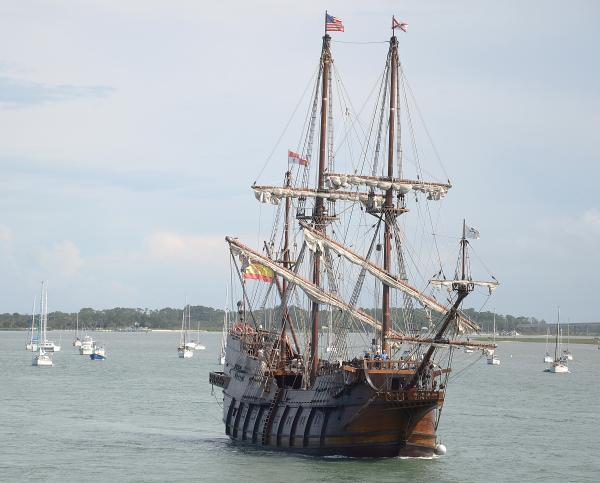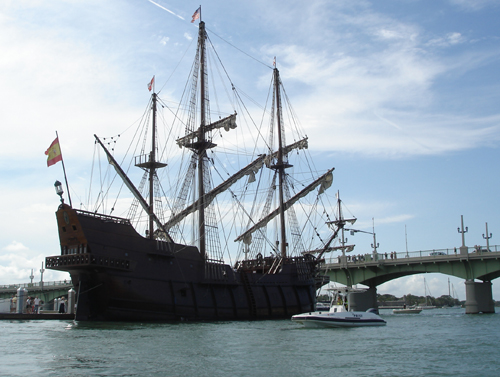
A replica of a Spanish galleon entering the harbor off downtown St. Augustine. While this is an authentic replica of vessels that were instrumental to the founding of our nation’s oldest port, no ship this large could have ever entered St. Augustine due to our shallow and treacherous inlet.
Yesterday we got a phone call from a St. Augustine city official, asking if a LAMP research vessel could help escort into our inlet a replica Spanish galleon. We had already heard the news that our city was to feature a visit from the galleon, as part of Florida’s 500th birthday celebration, and we have been looking forward to the day of its arrival! The galleon, named El Galeón Andalucía, is owned and operated by the Nao Victoria Foundation in Spain, and will be visiting four cities during its Florida tour. It measures 175 feet in length and is a 495 ton vessel. It is probably an accurate depiction of a medium to large sized galleon of the second half of the 16th century through first half of the 17th century.
Ironically, however, the sight of this galleon in our harbor, no matter how authentic the ship itself is, could never have been seen in our ancient city.

When Pedro Menéndez de Avilés first established St. Augustine, his flagship San Pelayo was a massive 906-ton galleon. There was no hope of a ship this size entering the inlet, even if fully unloaded, and Menendez ordered the flagship back to Hispaniola after offloading its supplies into small boats to ferry the cargo into the nascent port. But even galleons significantly smaller, and smaller than this replica, would have trouble navigating our shallow inlet. Menendez’ rival, the Frenchman Jean Ribault, sailed four galleons of his own down from Fort Caroline in present-day Jacksonville to attack the Spanish only days after Menendez landed here. Those galleons ranged in size from 120 to 160 tons, and yet they were still too large to safely enter the inlet. Instead of waiting for a higher tide, the French galleons sailed south to seek out San Pelayo and instead encountered a hurricane, which wrecked not only these ships but all hopes of a French colony in Florida.
Just over two hundred years later, another visitor to St. Augustine, the German surgeon Johann Schoepf, in 1784 described in great detail exactly how dangerous St. Augustine’s inlet was:
On account of the very flat coast it is difficult to find the site of Augustin; ships are often at a loss for several days. . . . We stood off and on before the bar, waiting for the pilot, who had been signaled for and shortly came over the so-called Swash and at 9 o’clock was on board. Helped by the incoming tide and a fresh north-east wind, the most favorable for entering craft, he carried us well over this dreadful bar, which had caused our young skipper many an anxious sigh all the way from Charleston. The steersman on the other hand, quite in the indifferent manner of an old sea-farer, had been entertaining the small company on board with numerous stories of ship-wreck and loss of life, always concluding with the statement that the bar before us could not be crossed without mortal danger, which was certainly no pleasant augury for those who were coming to St. Augustin out of sheer curiosity. Among the bars, which are so common on the southern coasts of North America, that before St. Augustin is unquestionably the most dangerous, because the shallowest and at the same time exposed to the total force of the ocean playing upon it. Ordinarily there are but 3, often only 2 channels where it can be crossed, and these at ebb-tide with only 4-4½ ft. of water, and at high tide with not more than 8-9. These channels which of themselves admit nothing but small and light vessels, are besides narrow and crooked, and what is worse they shift so generally after stormy weather, on account of the quick-sand which forms the bar, that a seaman, quite familiar with them, after a brief absence from Augustin cannot without risk take the old course to which he had been used. The pilots therefore as often as they come out to bring in a ship, must examine the passage anew. Nor will they take a vessel in or out except at flood tide, and the tide must not have reached its height; for in case the vessel fares ill, the rising tide would float it again, unless already broken by the heavy shocks, or those on board might with the help of boards &c. swim off to shore, which is about the only means of escape, since boats can be of no use in the circumstances. It is indeed a fearful thing to hear the wild tumult of these breaking seas and to behold them on all sides foaming and tossing, and it is no comfort, when one’s voyage is ended but for a mile or two, to be then exposed to the greatest danger of all, if the port, which is in plain sight, is really to be made.
Schoepf added that “It was Spanish wariness to fix the capital of a colony behind a sand-bank which cannot be crossed except at great peril.” Here he showed great historical insight. Pedro Menendez was first and foremost a sailor, even an admiral. He was in charge of Spain’s cross-Atlantic galleon convoy system and he certainly knew that the sand bar outside St. Augustine’s inlet would prevent large ships from entering. But after seeing the fate of Ribault’s invading galleons, he knew that nothing could protect this nascent military port better than the inlet itself. instead of changing his principle settlement to the deep-water port of Fort Caroline at modern-day Jacksonville, he chose to stay in St. Augustine. And that is why we are the oldest port in the nation!
Even if no Spaniard in St. Augustine’s history would have seen such a galleon on our bayfront, we can’t help but admire this beautiful replica and welcome her to our port. She will be open for tours through June 9, so if you are in the area, please come for a visit!

